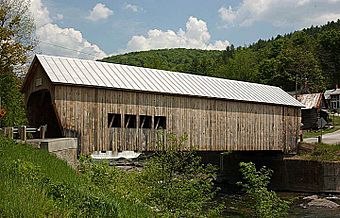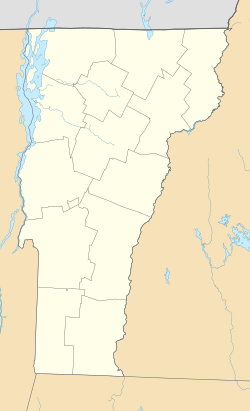Mill Covered Bridge (Tunbridge, Vermont) facts for kids
|
Mill Covered Bridge
|
|
|
U.S. Historic district
Contributing property |
|
 |
|
| Location | W of VT 110, over First Branch White River, Tunbridge, Vermont |
|---|---|
| Area | 1 acre (0.40 ha) |
| Built | 1883 |
| Architectural style | multiple Kingpost truss |
| Part of | Hayward and Kibby Mill (ID92000094) |
| NRHP reference No. | 74000243 |
Quick facts for kids Significant dates |
|
| Added to NRHP | July 30, 1974 |
| Designated CP | March 12, 1992 |
The Mill Covered Bridge is a special bridge in Tunbridge, Vermont. It carries Spring Road over the First Branch White River. This bridge is a copy of an older, historic covered bridge.
The first bridge was built in 1883. Sadly, it was damaged by ice in 1999. So, a new bridge was built in 2000. It looks almost exactly like the old one! This area, including Tunbridge and Chelsea, has many covered bridges. The original 1883 bridge was so important that it was added to the National Register of Historic Places in 1974.
Contents
What is the Mill Covered Bridge?
The Mill Covered Bridge is found on the north side of Tunbridge village. It helps Spring Road cross the First Branch White River. You can find it west of Vermont Route 110. It's also near the old Hayward and Kibby Mill buildings. This was a busy mill area in the 1800s.
How Was It Built?
This bridge has one main section that crosses the river. It uses a special design called a multiple kingpost truss. Think of a kingpost truss as a strong triangle shape. These trusses rest on supports made of stone and concrete.
The bridge is about 72.5 feet (22.1 m) long. It is 19 feet (5.8 m) wide in total. The part where cars drive is about 15.5 feet (4.7 m) wide. This means it's a one-lane bridge.
Strong and Sturdy Design
The wooden trusses are made even stronger with wrought iron rods. These metal rods help brace the bridge. Usually, other bridges use more wood for this. But the iron rods make this bridge extra sturdy.
The outside of the bridge has a metal roof. Its sides are covered with vertical wooden boards. These boards also go around the openings where cars enter. The floor inside is made of wooden planks. These planks run parallel to the main trusses.
A Look Back: The Original Bridge
The first Mill Covered Bridge was built around 1883. A local carpenter named Arthur G. Adams built it. He was known for building many of Tunbridge's covered bridges. There are five covered bridges still standing in Tunbridge today.
Why Are Covered Bridges Special?
These bridges, along with another one in nearby Chelsea, are very special. They show a large group of 19th-century covered bridges in Vermont. Covered bridges were built with roofs to protect their wooden parts. This helped them last longer against rain and snow.
The Bridge's Journey
In March 1999, the original bridge was badly damaged. Large chunks of ice floating down the river hit it. Because of the damage, the bridge had to be taken down. But people loved the bridge and its history. So, a new bridge was built the very next year. This new bridge looks almost exactly like the old one. It helps keep the history alive!



